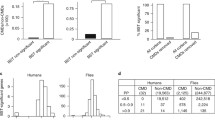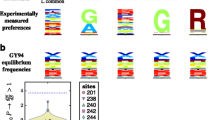Abstract
Using basic probability theory, we show that there is a substantial likelihood that even in the presence of strong purifying selection, there will be a number of codons in which the number of synonymous nucleotide substitutions per site (d S) exceeds the number of non-synonymous nucleotide substitutions per site (d N). In an empirical study, we examined the numbers of synonymous (b S) and non-synonymous substitutions (b N) along branches of the phylogenies of 69 single-copy orthologous genes from seven species of mammals. A pattern of b N > b S was most commonly seen in the shortest branches of the tree and was associated with a high coefficient of variation in both b N and b S, suggesting that high stochastic error in b N and b S on short branches, rather than positive Darwinian selection, is the explanation of most cases where b N is greater than b S on a given branch. The branch-site method of Zhang et al. (Zhang, Nielsen, Yang, Mol Biol Evol, 22:2472–2479, 2005) identified 117 codons on 35 branches as “positively selected,” but a majority of these codons lacked synonymous substitutions, while in the others, synonymous and non-synonymous differences per site occurred in approximately equal frequencies. Thus, it was impossible to rule out the hypothesis that chance variation in the pattern of mutation across sites, rather than positive selection, accounted for the observed pattern. Our results showed that b N/b S was consistently elevated in immune system genes, but neither the search for branches with b N > b S nor the branch-site method revealed this trend.






Similar content being viewed by others
References
Altschul SF, Madden TL, Schäffer AA, Zhang J, Zhang Z, Miller W, Lipman DJ (1997) Gapped BLAST and PSI-BLAST: a new generation of protein database search programs. Nucleic Acids Res 25:3389–3402
Bagley CJ, Woodcock JM, Guthridge MA, Stomski FC, Lopez AF (2001) Structural and functional hot spots in cytokine receptors. Int J Hematol 73:299–307
Benson DA, Karsch-Mizrachi I, Lipman DJ, Ostell J, Wheeler DL (2007) Genbank. Nucleic Acids Res 35:D21–D25
Doherty PC, Zinkernagel RM (1975) Enhanced immunologic surveillance in mice heterozygous at the H-2 complex. Nature 256:50–52
Dunn OJ (1964) Multiple comparisons using rank sums. Technometrics 6:241–252
Dunne A, O’Neill LA (2005) Adaptor usage and Toll-like receptor signaling specificity. FEBS Lett 579:3330–3335
Evans PD, Anderson JR, Vallender EJ, Choi SS, Lahn BT (2004) Reconstructing the evolutionary history of microcephalin, a gene controlling human brain size. Human Mol Genet 13:1139–1145
Evans PD, Vallender EJ, Lahn BT (2006) Molecular evolution of the brain size regulator genes CDK5RAP2 and CENPJ. Gene 375:75–79
Hubbard TJ, Aken BL, Beal K, Ballester B, Caccamo M, Chen Y, Clarke L, Coates G, Cunningham F, Cutts T, Down T, Dyer SC, Fitzgerald S, Fernandez-Banet J, Graf S, Haider S, Hammond M, Herrero J, Holland R, Howe K, Howe K, Johnson N, Kahari A, Keefe D, Kokocinski F, Kulesha E, Lawson D, Longden I, Melsopp C, Megy K, Meidl P, Ouverdin B, Parker A, Prlic A, Rice S, Rios D, Schuster M, Sealy I, Severin J, Slater G, Smedley D, Spudich G, Trevanion S, Vilella A, Vogel J, White S, Wood M, Cox T, Curwen V, Durbin R, Fernandez-Suarez XM, Flicek P, Kasprzyk A, Proctor G, Searle S, Smith J, Ureta-Vidal A, Birney E (2007) Ensembl 2007. Nucleic Acids Res 35:D610–D617
Hughes AL (1997) Rapid evolution of immunoglobulin superfamily domains expressed in immune system cells. Mol Biol Evol 14:1–5
Hughes AL (1999) Adaptive evolution of genes and genomes. Oxford University Press, New York
Hughes AL (2007) Searching for Darwin in all the wrong places: the misguided quest for positive selection at the molecular level. Heredity 99:364–373
Hughes AL, Friedman R (2005) Variation in the pattern of synonymous and nonsynonymous difference between two fungal genomes. Mol Biol Evol 22:1320–1324
Hughes AL, Nei M (1988) Pattern of nucleotide substitution at MHC class I loci reveals overdominant selection. Nature 335:167–170
Hughes AL, Hughes MK, Howell CY, Nei M (1994) Natural selection at the class II major histocompatibility complex loci of mammals. Philos Trans R Soc Lond B 346:359–367
Hughes AL, Ekollu V, Friedman R, Rose JR (2005a) Gene family content-based phylogeny of prokaryotes: the effect of search criteria. Syst Biol 54:268–276
Hughes AL, Packer B, Welsch R, Chanock SJ, Yeager M (2005b) High level of functional polymorphism indicates a unique role of natural selection at human immune system loci. Immunogenetics 57:821–827
Hughes AL, Friedman R, Glenn NL (2006) The future of data analysis in evolutionary genomics. Curr Genomics 7:227–234
Huntley MA, Golding GB (2004) Neurological proteins are not enriched for repetitive sequences. Genetics 166:1141–1154
Jones DT, Taylor WR, Thornton JM (1992) The rapid generation of mutation data matrices from protein sequences. Comput Appl Biosci 8:275–282
Kimura M (1977) Preponderance of synonymous changes as evidence for the neutral theory of molecular evolution. Nature 267:275–276
Kouprina N, Pavlicek A, Mochida GH, Solomon G, Gersch W, Yoon Y-H, Collura R, Ruvolo M, Barrett JC, Woods CG, Walsh CA, Jurka J, Larionov V (2004) Accelerated evolution of the ASPM gene controlling brain size begins prior to human brain expansion. PloS Biol 2:0653–0663
Lustgarten J, Waks T, Eshhar Z (1991) CD4 and CD8 accessory molecules function through interactions with major histocompatibility complex molecules which are not directly associated with the T cell receptor–antigen complex. Eur J Immunol 21:2507–2515
Murphy PM (1993) Molecular mimicry and the generation of host defense protein diversity. Cell 72:823–826
Nei M (1987) Molecular evolutionary genetics. Columbia University Press, New York
Nei M, Gojobori T (1986) Simple methods for estimating the numbers of synonymous and nonsynonymous nucleotide substitutions. Mol Biol Evol 3:418–426
O’Connor DH, McDermott AB, Krebs AC, Dodds EJ, Miller JE, Gonzalez EJ, Jacoby TJ, Yant L, Piontkivska H, Pantophlet R, Burton DR, Rehrauer WR, Wilson N, Hughes AL, Watkins DI (2004) A dominant role for CD8+-T-lymphocyte selection in simian immunodeficiency virus sequence variation. J Virol 78:14012–14022
Ohta T (2002) Near-neutrality in evolution of genes and gene regulation. Proc Natl Acad Sci U S A 99:16134–16137
Pavlicek A, Jurka J (2006) Positive selection on the nonhomologous end-joining factor Cernunnos-XLF in the human lineage. Biol Direct I:15
Ripley LS (1999) Predictability of mutant sequences: relationships between mutational mechanisms and mutant specificity. Ann NY Acad Sci 870:159–170
Saitou N, Nei M (1987) The neighbor-joining method: a new method for reconstructing phylogenetic trees. Mol Biol Evol 4:406–425
Schmidt HA, Strimmer K, Vingron M, von Haeseler A (2002) TREE-PUZZLE: maximum likelihood phylogenetic analysis using quartets and parallel computing. Bioinformatics 18:502–504
Schneider A, Cannarozzi G, Gonnet GH (2005) Empirical codon substitution matrix. BMC Bioinformatics 6:134
Swofford DL (1999) PAUP*: Phylogenetic analysis using parsimony (*and other methods). Sunderland MA, Sinauer
Thompson JD, Higgins DG, Gibson TJ (1994) CLUSTAL W: improving the sensitivity of progressive multiple sequence alignment through sequence weighting, positions-specific gap penalties and weight matrix choice. Nucleic Acids Res 22:4673–4680
Wang Y, Su B (2004) Molecular evolution of microcephalin, a gene determining human brain size. Human Mol Genet 13:1131–1137
Wong KM, Suchard MA, Huelsenbeck JP (2008) Alignment uncertainty and genomic analysis. Science 319:473–476
Yang Z (1997) PAML: a program package for phylogenetic analysis by maximum likelihood. Comput Appl Biosci 13:555–556
Yang Z (1998) Likelihood ratio tests for detecting positive selection and application to primate lysozyme evolution. Mol Biol Evol 15:568–573
Yang Z, Wong WS, Nielsen R (2005) Bayes empirical Bayes inference of amino acid sites under positive selection. Mol Biol Evol 22:1107–1118
Zhang J, Rosenberg HF, Nei M (1998) Positive Darwinian selection after gene duplication in primate ribonuclease genes. Proc Natl Acad Sci U S A 98:3708–3713
Zhang J, Nielsen R, Yang Z (2005) Evaluation of an improved branch-site likelihood method for detecting positive selection at the molecular level. Mol Biol Evol 22:2472–2479
Acknowledgment
This research was supported by grant GM43940 from the National Institutes of Health.
Author information
Authors and Affiliations
Corresponding author
Electronic supplementary material
Below is the link to the electronic supplementary material
ESM Table S1
(XLS 10 KB)
Rights and permissions
About this article
Cite this article
Hughes, A.L., Friedman, R. Codon-based tests of positive selection, branch lengths, and the evolution of mammalian immune system genes. Immunogenetics 60, 495–506 (2008). https://doi.org/10.1007/s00251-008-0304-4
Received:
Accepted:
Published:
Issue Date:
DOI: https://doi.org/10.1007/s00251-008-0304-4




